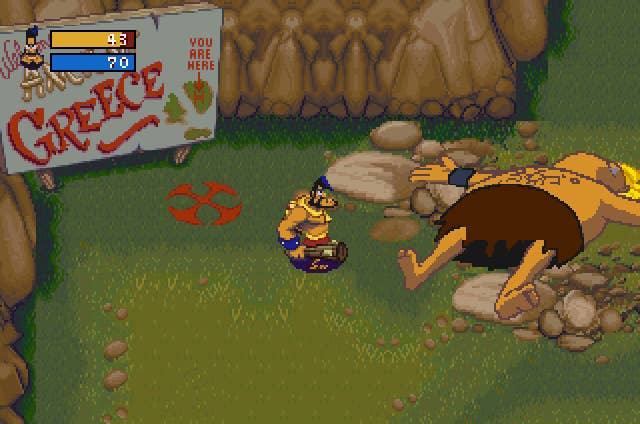Virtual Spotlight: Herc's Adventures
Finally, a 32-bit cult classic gets its day in the sun.
This article first appeared on USgamer, a partner publication of VG247. Some content, such as this article, has been migrated to VG247 for posterity after USgamer's closure - but it has not been edited or further vetted by the VG247 team.
So here's the weird thing about Herc's Adventures: Its lead designers (Dean Hall and Mike Ebert) also worked on 1993's Super NES classic Zombies Ate My Neighbors – but not, for some reason, ZAMN's official sequel, Ghoul Patrol. But despite its radically different setting and characters, Herc's Adventures is every bit as much a ZAMN sequel as Ghoul Patrol.
The other weird thing about Herc's Adventures is that Sony published it yesterday as one of PSN's PlayStation classics, yet somehow decided this fact wasn't worth trumpeting from the mountaintops. Never mind that the game sells for about $100 on the aftermarket and is one of the coolest cult classics in the PlayStation library. Never mind that it's one of the last examples of classic LucasArts game design before the company abandoned every concept that didn't have to do with Star Wars or Indiana Jones.
Actually, Herc's Adventures may have played a part in the company's abandonment of original concepts. I can't imagine it sold well at all (the fact that it commands such a high aftermarket price suggests that there aren't a lot of copies out in the wild). It was a deeply, impossibly unfashionable release delivered by good-hearted people into a changing, uncaring world. Its arcade-hard action and sumptuous hand-drawn artwork couldn't have been more out of place in the PlayStation universe of 1998, a time in which everything was made of chunky rectangles.

Like its fellow 2D PlayStation rarities, though, the same detailed 2D artwork that made Herc's Adventures so unhip among its contemporaries has helped it to age with far more grace than its cooler peers. Where the sloppy low-count polygons of, say, Croc: Legend of the Gobbos or Syphon Filter come across as an eyesore today, the lovingly crafted sprites of Herc's Adventure still look great. It really is a rare creature: An action game, for consoles, that featured the same fluid hand-drawn whimsy of the company's PC adventure titles. Unhindered by sluggish console processors and cramped 16-bit cartridges, Hall and Ebert unleashed the keen artistry of LucasArt's original creations onto PlayStation (and Saturn, but the PSN release is the PlayStation version, technologically inferior as it may be) for a tantalizing collision of two worlds that had never properly intersected before then... and, sadly, would never collide again.
And the game was loads of fun, too. Is loads of fun. Either one or two players could go stomping through the world of Ancient Greece as one of three mythic heroes (Hercules, Jason of Argonauts fame, or Atlanta aka Atalanta). The top-down perspective revealed a largely nonlinear world akin to a Zelda game, with melee combat and plenty of dangerous monsters to contend with, including huge and intricately animated cyclopses. As might be expected from classic LucasArts, Herc's Adventure didn't take itself entirely seriously, with tons of visual gags (e.g. alien astronauts marauding around the feet of the Pyramids) and amusing anachronisms (e.g. gyros as health recovery items, because after all this is Greece).

What really cemented Herc's Adventures in my memory, though, was its interesting approach to death. Once a character's life bar ran out, that was it – they died, permanently. There were no continues, a very unusual design choice for such a sprawling action-adventure title. However, death wasn't necessarily game over, and upon falling in battle that character would awaken in Hades' realm with their skills intact. It was possible to simply fight your way out of hell, bludgeoning the enemy hordes and returning to the land of the living, Orpheus-style. But with each trip into the underworld, the player would awaken a little further in from the Styx, forcing them to fight harder to escape each time, until eventually they ended up so far in that they simply couldn't break free. It made for an interesting and fairly risky design choice, though the prospect of being caught forever in Hades made the game's finale – which sees the hero/heroes march right back into hell to beat the God of the Underworld himself to a pulp – all the more satisfying.
While not a perfect game by any means, Herc's Adventure is a fantastic glimpse into an all-too-brief slice of the past: An era where an amusing, visually archaic, and yet somehow convention-challenging action game could see the light of day from a major publisher on a major console. Of course, its subsequent commercial performance and resulting rarity also demonstrate exactly why this sort of game only comes from indie studios now. But hey, PlayStation's all about the indies these days, right?
ConclusionWhimsical, dumb, challenging, and fun. Why not download Herc's Adventures and find it a new home alongside the likes of Spelunky and Tokyo Jungle? It'll fit right in.
